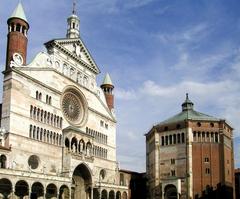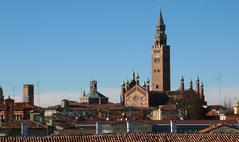
Cremona Casalmaggiore Tramway: Visiting Hours, Tickets, and Travel Guide
Date: 04/07/2025
Introduction
The Cremona–Casalmaggiore tramway, nestled in the heart of Lombardy, Italy, is a captivating chapter in regional transportation history. Inaugurated in 1888, this historic line not only linked the vibrant city of Cremona—famed for its violin-making tradition—with the picturesque town of Casalmaggiore, but also played a transformative role in fostering economic growth, cultural exchange, and social cohesion across the province. Though the original tram service ceased in 1954, its legacy remains alive through heritage sites, museums, and the contemporary K203 bus route that traces its historic corridor. This guide offers a comprehensive overview of the tramway’s origins, socio-economic impact, technical features, and practical visitor information—ensuring an enriching experience for history enthusiasts, cultural travelers, and explorers alike. For official resources on schedules, ticketing, and travel tips, consult the Arriva Italia website and the Museo Civico Ala Ponzone (it.wikipedia, terredamare.com, Neuralword).
Table of Contents
- Introduction
- Historical Overview
- Visiting Today
- Exploring the Historic Route
- Modern Operations
- Summary & Recommendations
- References
Historical Overview
Early Proposals and Conception
The tramway’s story began in the 1880s, amid rapid industrialization and expanding transport networks in northern Italy. The Province of Cremona allocated significant funds to advance regional tramway projects, and after planning and approvals, the Cremona–Casalmaggiore line opened on July 13, 1888. Initially managed by Società Tranvie nella provincia di Cremona, it quickly became a backbone for regional mobility (it.wikipedia).
Expansion and Branch Lines
The tramway added branches to San Giovanni in Croce and Ponte Majocche, enhancing access to rural communities and integrating with major railway lines like the Piadena-Parma railway and the Mantova-Viadana tramway. These expansions cemented the tramway’s role as a vital connector for both passengers and freight.
Technical and Operational Developments
Originally powered by steam locomotives on narrow-gauge tracks, the line prioritized reliability and integration with regional transit. Later, internal combustion railcars were introduced, improving services until 1951. Ambitious plans for electrification and new lines were halted by World War I and financial constraints.
Ownership and Administrative Changes
In 1899, ownership transferred to the Società Nazionale Ferrovie e Tramvie (SNFT), which oversaw operational improvements and linked the tramway more closely with existing rail infrastructure.
Socio-Economic Impact
The tramway fostered economic growth and cultural exchange by supporting local agriculture, industry, and commerce. It improved access for rural communities, stimulated markets, and enabled participation in urban life.
Decline and Closure
Increased competition from road transport led to a phased closure: trams were replaced by buses in 1954, and the last lines closed in 1955.
Legacy and Remnants
While few original structures remain, local historians and museums preserve the tramway’s story. Former stations and routes have been repurposed, and the line’s legacy is reflected in regional heritage initiatives.
Visiting the Cremona Casalmaggiore Tramway Today
Hours and Accessibility
Although the original tramway is no longer operational, its heritage is showcased at sites like the Museo Civico Ala Ponzone in Cremona (open Tuesday–Sunday, 9:00 AM–5:00 PM, with full accessibility). Interpretive signage and remnants can be found in towns such as Cella Dati and Casalmaggiore.
Tickets and Guided Tours
Museum entry is typically €5 for adults, with discounts for students and seniors. Guided tours focusing on the tramway and local transport heritage are available by appointment. Most heritage sites are accessible without charge, though donations may be requested for guided experiences.
Travel Tips
Reach Cremona by train or car; the city’s compact center and local buses make navigation easy. Biking along the former tramway corridors offers a scenic journey through the Po Valley landscapes.
Nearby Attractions
Combine your visit with Cremona’s top sites: the Torrazzo—one of Italy’s tallest bell towers; the Museo del Violino; and the city’s historic piazzas. Casalmaggiore offers riverside walks and cultural venues, while smaller villages along the route retain their rural charm.
Exploring the Historic Route: Key Stops, Travel Tips & Attractions
Overview and K203 Bus
The K203 bus line now follows the tramway’s original route, connecting Cremona with Casalmaggiore and intermediate towns. The journey traverses the Po Valley, offering both historical context and scenic landscapes (Moovit).
Key Stops and Attractions
- Cremona Autostazione: Gateway to the city center, Torrazzo, Cathedral, and Museo del Violino (Turismo Cremona).
- Bonemerse: Traditional Lombard farmsteads and irrigation canals.
- Forcello and Pieve d’Olmi: Picturesque agricultural communities and proximity to river floodplains.
- San Daniele Po: Access to river trails and nature reserves.
- Solarolo Paganino/Monasterolo: Historic churches and rural architecture.
- Scandolara Ravara: Community events and local markets.
- Casalmaggiore: Teatro Comunale, Museo Diotti, vibrant piazzas, and riverside promenades (Bargain Travel Europe).
Practical Visitor Information
- Tickets: Available at Cremona Autostazione, local retailers, or online (Arriva Italia). Full-route fare: ~€3.30.
- Schedules: K203 runs weekdays from 06:48 to 12:10; check real-time updates on the Moovit app.
- Accessibility: Buses are wheelchair accessible and allow bicycles (space permitting).
- Combining Visits: Plan stops for sightseeing, photo opportunities, and sampling local cuisine along the “Strada del Gusto Cremonese.”
Cultural Significance
The route connects not only physical places, but also culinary traditions and living heritage. Many villages feature seasonal festivals, markets, and culinary events, providing visitors with authentic local experiences.
Modern Operations: Cremona Casalmaggiore Tramway Today
Current Service Features
The K203 bus, managed by Arriva Italia, is equipped with low-floor platforms, air conditioning, Wi-Fi, and energy-saving technologies. The journey takes about 30 minutes and is designed for comfort, inclusivity, and environmental sustainability (Neuralword).
Ticketing and Visiting Hours
- Hours: Frequent departures from early morning to late evening; always check the Arriva Italia website for seasonal updates.
- Tickets: Use the Arriva MyPay app or purchase at authorized outlets. The “Io Viaggio” electronic card is available for regular commuters.
- Validation: Tap your card or ticket upon boarding. Digital solutions reduce waste and streamline travel.
Passenger Experience and Accessibility
- Multilingual signage and announcements.
- Low-floor vehicles for wheelchair and stroller access.
- Real-time updates and friendly staff.
- Small pets allowed in carriers; family-friendly features.
Connecting with Lombardy’s Heritage
The route offers panoramic views of the Po Valley, access to urban landmarks, rural scenery, and riverside attractions. It is also a gateway to regional events like the Cremona Summer Festival.
Practical Tips
- Plan ahead: Timetables may vary for festivals or construction.
- Buy tickets in advance: Use digital apps for convenience.
- Accessibility: Vehicles are fully accessible for all travelers.
Environmental and Social Impact
The tramway-turned-bus line helps reduce private car use, supports local businesses, and enhances community life while minimizing environmental impact (Neuralword).
Service Updates and Customer Support
Visit the Arriva Italia website for updates on construction or service changes. The Cremona Tourist Office provides maps, itineraries, and personalized support.
Visuals and Interactive Elements
Explore high-quality images, interactive route maps, and virtual tours on the official websites. Visual content features the tramway’s scenic route, stations, and key attractions.
Frequently Asked Questions (FAQ)
Q: Is the original tramway still operational?
A: No, the tram ceased operations in 1954. The K203 bus now follows its route.
Q: Where can I learn more about the tramway’s history?
A: Visit the Museo Civico Ala Ponzone and local museums, or check online resources.
Q: How do I buy tickets for the K203 bus?
A: Use the Arriva MyPay app, purchase at Cremona Autostazione, or buy from authorized retailers.
Q: Is the route accessible?
A: All buses and major stops are wheelchair accessible.
Q: Can I combine the tramway visit with other attractions?
A: Yes, the route connects directly to Cremona’s landmarks and Casalmaggiore’s historical sites.
Q: Are there discounts or tax deductions?
A: Italian residents may be eligible for tax deductions on transport subscriptions.
Summary and Recommendations
The Cremona–Casalmaggiore tramway exemplifies the powerful interplay between transportation, economic vitality, and cultural heritage in Lombardy. Visitors today can engage with this history through well-preserved museums, accessible bus routes, and vibrant regional events. Whether you seek to explore urban landmarks, rural landscapes, or riverside scenery, the route provides a comfortable, sustainable, and enriching travel experience. For up-to-date information, tickets, and event schedules, visit official sources such as the Arriva Italia website and the Cremona Tourism Board.
Travel Tips:
- Combine your journey with local festivals or culinary trails for an authentic experience.
- Use digital ticketing and real-time updates for seamless travel.
- Plan ahead for museum hours, guided tours, and special events.
References and Further Reading
- Cremona Casalmaggiore Tramway: A Historical Journey and Visitor’s Guide, 2025 (it.wikipedia)
- Exploring the Cremona–Casalmaggiore Tramway: History, Visitor Info, and Nearby Attractions, 2025 (terredamare.com)
- Exploring the Historic Cremona–Casalmaggiore Tramway Route: Key Stops, Travel Tips & Attractions, 2025 (Moovit)
- Cremona Casalmaggiore Tramway: Visiting Hours, Tickets & Travel Guide to Lombardy’s Historic Route, 2025 (Arriva Italia)
- FEDECRAIL Annual Plan 2025, 2025 (fedecrail.org)
- Museo Civico Ala Ponzone Official Website, 2025 (musei.comune.cremona.it)
- Cremona Tourism Board, 2025 (turismocremona.it)
- Bargain Travel Europe: Casalmaggiore, 2025 (Bargain Travel Europe)
- Neuralword: Cremona Casalmaggiore Tram Service, 2025 (Neuralword)
Image alt text: Historic Cremona–Casalmaggiore Tramway Station showcasing preserved architecture and signage.




